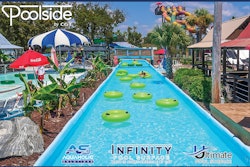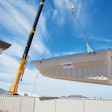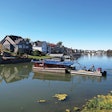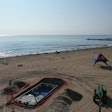
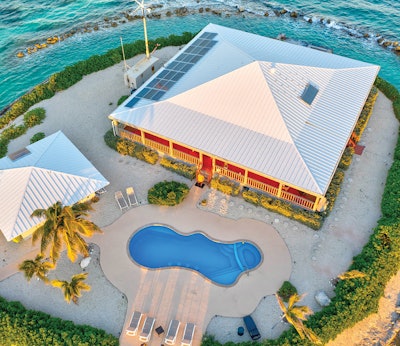
One of his most memorable and challenging projects, at 1 East Sister Rock Island and located about a mile off the Marathon Coast, went on the real estate market earlier this year for $11.7 million. It’s a private island that’s also a popular Airbnb destination, and you might have seen a drone photo of it in memes, too.
But rather than the 38-foot-long freeform San Juan fiberglass pool with a spillover spa that is now nestled in between the island’s 2,300-sq.-ft. home, a guesthouse and a helipad (all of which, incidentally, are ringed by a moat), the island originally featured an aboveground vinyl-liner pool surrounded by trees.
Then, in September 2017, along came Hurricane Irma — which pummeled the Florida Keys as a Category 4 storm and ripped apart East Sister Rock Island. “The only thing really left standing was the house,” Miller recalls, noting that everything from electrical generators and landscaping to the moat and aboveground pool were wiped out. “The house was built so well that it was only dinged up a little bit. Structurally, it was fine. The rest of the island was destroyed, though, and the homeowner and his two sons brought it back to life.” The trio took out a long-term lease on a track hoe, which was barged over to the island from the mainland, and used it to rebuild much of the island by redistributing the fill that Irma stirred up. Then, in 2019, Miller got the call.
RELATED: On a Steep Slope
“They got a hold of me and asked if I wanted to put a pool in,” he says. “I told them, ‘Sure.’”
 Pool and digger loaded up and ready to sail. On a clear, calm day, this barge works fine for logistical transport.
Pool and digger loaded up and ready to sail. On a clear, calm day, this barge works fine for logistical transport. Arch enemy of tiny island pool homes: hurricanes. Here, Hurricane Irma wreaks destruction on 1 East Sister Rock Island in September 2017. The island itself was rebuilt with fill to support a 2,300-sq.-ft. home and San Juan fiberglass pool.
Arch enemy of tiny island pool homes: hurricanes. Here, Hurricane Irma wreaks destruction on 1 East Sister Rock Island in September 2017. The island itself was rebuilt with fill to support a 2,300-sq.-ft. home and San Juan fiberglass pool. The same site as it appears today.
The same site as it appears today.SPECIAL DELIVERIES
This project didn’t turn out to be as straightforward as most of Miller’s other island installations — although it began similarly.
“I went through the logistics with them, because the only way to get a fiberglass pool to the island is by boat or barge,” he says. “The excavator was still on the island, so we used it to dig the hole. All the sand and pea gravel that we used underneath the pool as its base and for backfill had to be brought in by a small boat that couldn’t have been more than 28 feet long. We put the sand in big bags, and then the excavator reached out to the boat, picked up each bag and loaded it onto the property. Then, we loaded the pool onto a barge and hauled
it out to the island. Of course, we couldn’t get it across the moat, but the machine was big enough that it could reach out, grab the pool and place it on land. That’s basically how we built the whole thing.”
Transporting the sand and pea gravel alone took several days, according to Miller — each of which involved countless back-and-forth trips between the mainland and
the island until all of the material was delivered. Using the barge that carried the pool shell to transport the sand and pea gravel would have been less time-consuming but much more expensive, he says. Fortunately for Precision Fiberglass Pools of the Keys, Miller and his crew were not responsible for hauling the sand across the water and could work on other projects during that phase.
The fill excavated for the pool also was used on the island as part of the owner’s rebuilding process, and there was plenty of room on the island for the equipment, Miller’s three-man crew and the pool owner’s family.
“After I got the pool level, I ran the plumbing and then scheduled an inspection,” Miller says, adding most islands in the Keys are protected lands, and pool projects require additional approvals from local, state and/or federal entities. “The inspector usually meets us on the mainland, and we bring him out to the island. We never have a problem scheduling inspections, because inspectors like to go out to the island. That’s the easy part.”
RELATED: Splendid Spa Installations
"As for making daily crossings from the Marathon mainland to the island, Miller and his crew relied on transportation via a boat operated by the homeowner’s sons. The family lived in Miami and used the property as a vacation home, and construction only took place when the island was occupied.
 This photo is included because this is where the author of this story would like to wake up in the morning.
This photo is included because this is where the author of this story would like to wake up in the morning.'EVERYTHING TURNED OUT BEAUTIFUL'
Fittingly, the San Juan Fiberglass Pools model Miller installed on the property is called Pleasure Island and includes bar seating for four and a tanning ledge. Miller was not involved in any of the landscaping, not even the deck.
“At first, the owner was going to put a paver tile deck on, but then they decided it might be better to do a concrete deck,” Miller chuckles. “I said getting concrete out here to pour a deck — that could be a little tough. But what they did was load up 80-lb bags of concrete on that boat, brought them out to the island and mixed the concrete on site. I didn’t want to be part of that. It would have taken a long time and wore my guys out.”
Miler thinks that if an inground pool had been on East Sister Rock Island when Irma hit, rather than an aboveground pool, it would have withstood the storm’s fury.
 The pool itself is nothing elaborate, just a tidy fiberglass with attached spa, clean, well-executed coping and concrete deck. The trick is doing it out in the ocean, shipping in all supplies and equipment.
The pool itself is nothing elaborate, just a tidy fiberglass with attached spa, clean, well-executed coping and concrete deck. The trick is doing it out in the ocean, shipping in all supplies and equipment.“A mile away from the island, inland but real close to the shore, I’ve built probably 50 pools right down Sombrero Beach Road in Marathon, and all of those were fine,” he says. “They had a lot of junk in them, and we had to pump them out and clean them, but they didn’t have any damage. And we’ve gone through several hurricanes.”
RELATED: Choose Your Own Adventure
That’s worth noting — especially for pool professionals in hurricane- prone regions with customers convinced all they need is an aboveground pool.
As for the pool at 1 East Sister Rock Island and the unconventional challenges it presented? Just part of doing business in the Florida Keys, according to Miller.
“You have to plan ahead for what you need,” he says. “There have been a couple of pools I’ve built that we actually just put the pool in the water, hooked it onto a boat and had the boat tow it to the island. We had access to a barge for this one, because of the excavator, but we usually use boats to pull the pools to the jobsite.”
All told, Miller’s portion of the project took about three months. “Everything turned out beautiful,” he says. “It’s just absolutely amazing, because the island was pretty much destroyed. It took a while, and the owner and his sons worked their butts off. But they were so energetic, and it all worked out. We had a good relationship.”





























